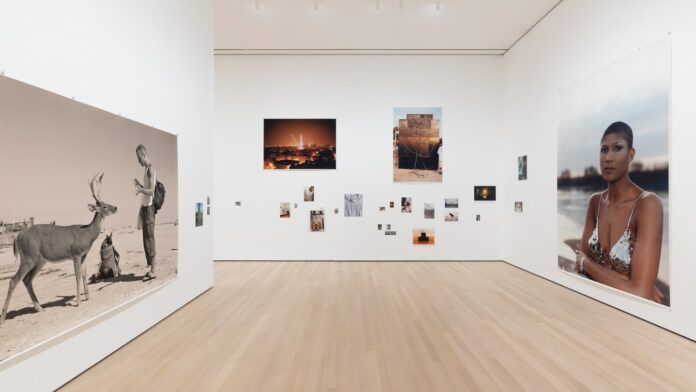
I am talking, of course, about the 1990s — possibly my ’90s, but especially the German photographer Wolfgang Tillmans (b. 1968) and his ’90s.
Tillmans’s photographs, from the 1990s and beyond, fill a vast suite of galleries at New York’s Museum of Modern Art in a retrospective titled “To Look Without Fear” (it will travel to the Art Gallery of Ontario in Toronto, then the San Francisco Museum of Modern Art in 2023). The show is full of humor, compassion and surprise. I love the way it is hung, with enormous prints covering huge expanses of wall beside clusters of tiny snapshots, most of them taped to the wall, but some thrown into corners or placed beside emergency-exit signs. The show made me so nostalgic that at times, I wanted to crouch down and weep.
Yet I am of two minds about what it amounts to. Is Tillmans a great photographer? A great artist? Does he really deserve a retrospective at MoMA?
I mean, sure. Why not? Tillmans, 54, has been around a long time, and there is something exemplary about him. But remove the halo of ’90s nostalgia and he is essentially a snapshot and fashion photographer blessed by the zeitgeist and turbocharged by ambition.
The MoMA exhibition comes with a hefty catalogue and a 352-page Wolfgang Tillmans “Reader.” The implication — that Tillmans is not only a photographer, but also some sort of heavyweight public intellectual — is stretching it a bit. I’d invoke Susan Sontag’s definition of camp as “failed seriousness,” but I see the back-cover blurb by John Waters, the “king of camp,” is a step ahead: “Can printed museum art-talk be so smart, that it becomes sexually arousing for the reader?” concludes Waters, after a sequence of comically hyperbolic effusions. “Sure it can.”
If it seems odd that MoMA has devoted its entire sixth-floor exhibition space to Tillmans, it’s also instructive. MoMA is no longer the MoMA of old. For a long time it tried — how it tried — to hold back the barbarian tide. But it finally had to concede that, outside its walls, old hierarchies of cultural value had collapsed. Today, we are permitted to wonder — aloud if we like! — whether Picasso was as great as everyone claims. We can dare to suggest that a photograph or a dress might carry as much weight as a painting or a bronze sculpture.
When did this happen? When was the prestige that adhered to certain forms of culture most drastically stripped away?
Why, in the 1990s, of course.
Previous surges in this direction occurred in Paris in the 1870s (the Impressionists) and in New York in the 1950s, when avant-garde artists and poets embraced chance and collage along with the idea that commodities and everyday experience might be elevated into poetry (Frank O’Hara, John Ashbery) and fine art (Robert Rauschenberg, Andy Warhol).
But these were skirmishes. The 1990s saw the quivering membrane still separating “high” art from the everyday completely give way. The result? A rout. Credibility drained from the idea of “elevated” culture, while previously patronized “lowly” forms, such as television, rap and fashion, became turbines of (often collective) creativity.
The 1990s was the decade in which all kinds of repressions and stigmas were lifted, but in a room, alas, from which all the old meanings had been sucked. This was at once liberating and depressing. Signals were jammed. Confusion reigned. The Berlin Wall had come down — hooray! — but no one knew who controlled the nukes anymore. One Communist empire had collapsed, while another — China — was embracing capitalism. HIV infection rates had stabilized in the United States and Europe, but in sub-Saharan Africa, the virus was exacting a terrifying toll.
It was a decade in which a British magazine could declare — in the knowledge that its readers would instantly get it — that Kate Moss was “the face of the ’90s — the face that reminds you your optimism was misplaced.” And it was a decade from which Tillmans emerged as somehow quintessential.
In the 1990s, Tillmans took photographs of friends and windowsills, of hairy armpits, boring architecture, ecstatic dance parties and the detritus left over in the morning. He photographed Moss and Waters and Michael Stipe and nightclubs and boys going to war. His photographs were displayed in galleries and published in alternative fashion magazines.
This was the era both of Nirvana and the Pet Shop Boys. Fashion was no longer conforming to the top-down model, whereby prestigious fashion houses set trends that were followed, in diluted form, on the street. Instead, the big brands were watching, and co-opting, style decisions (and non-decisions) made on the street. All of this was reflected in the fashion photographs of Corinne Day, Glenn Luchford, Steven Meisel, Mario Sorrenti and Juergen Teller, but none of these photographers gained a secure foothold in the art world.
Tillmans did. He was smart, and articulate, and he wanted it more.
Early on, he embraced the snapshot aesthetic of Nan Goldin, but he shrugged off Goldin’s heavily autobiographical narratives. His vision was more disinterested, more ecumenical. Everything caught his attention — not just people. If his subjects seemed random, they were random like life, where one day you might be peering into an airplane cockpit or examining fungus on a dead tree and the next you might be staring into the eyes of a beautiful man with a shaved head and surprisingly red ears.
Tillmans’s abstractions, many of which are included in this show, are also rooted in chance. These are beautiful, dreamy images, made without a camera by exposing light-sensitive paper to different light sources. Printed on the scale of museum-ready abstract paintings, they are reminiscent of the work of fellow Germans Sigmar Polke and Gerhard Richter.
Richter’s endless toggling between photographs and large-scale abstract paintings showed the high-art world that an apprehension of meaninglessness and a technique dependent on chance could nonetheless produce images of ravishing beauty. Tillmans followed the same playbook. If he doesn’t seem as original or quite as compelling as Richter or Polke, that, too, feels symptomatic of the ’90s, when almost everyone labored under the illusion that everything had already been done.
Tillmans has marveled at “how in real life we find our actions to be always already one step ahead of their social and behavioral descriptions.” This idea — that we escape our descriptions — comes through powerfully at MoMA, and it is what I love most about Tillmans. He himself is more than a gay artist, or a German artist; more than a fashion photographer, a portraitist or a political activist.
And, of course, he is more than a “ ’90s photographer.” Since the end of that decade, he has continued to make strong work. More recent subjects have included Frank Ocean, June Leaf, the moon and poured concrete. His sense of beauty, fragility and singularity remains intact.
My advice, when you visit this show, is to set aside the Wolfgang Tillmans “Reader” and forget about intellectualizing the ’90s, and let the photographs simply wash over you. (The absence of wall labels really helps). You may find them banal, as in some ways they deliberately are. But you may also perceive, as another German — Herman Hesse — wrote in an earlier era, “how incomprehensible everything was, and actually sad, although it was so beautiful.”
Wolfgang Tillmans: To Look Without Fear Through Jan. 1 at the Museum of Modern Art, New York.








